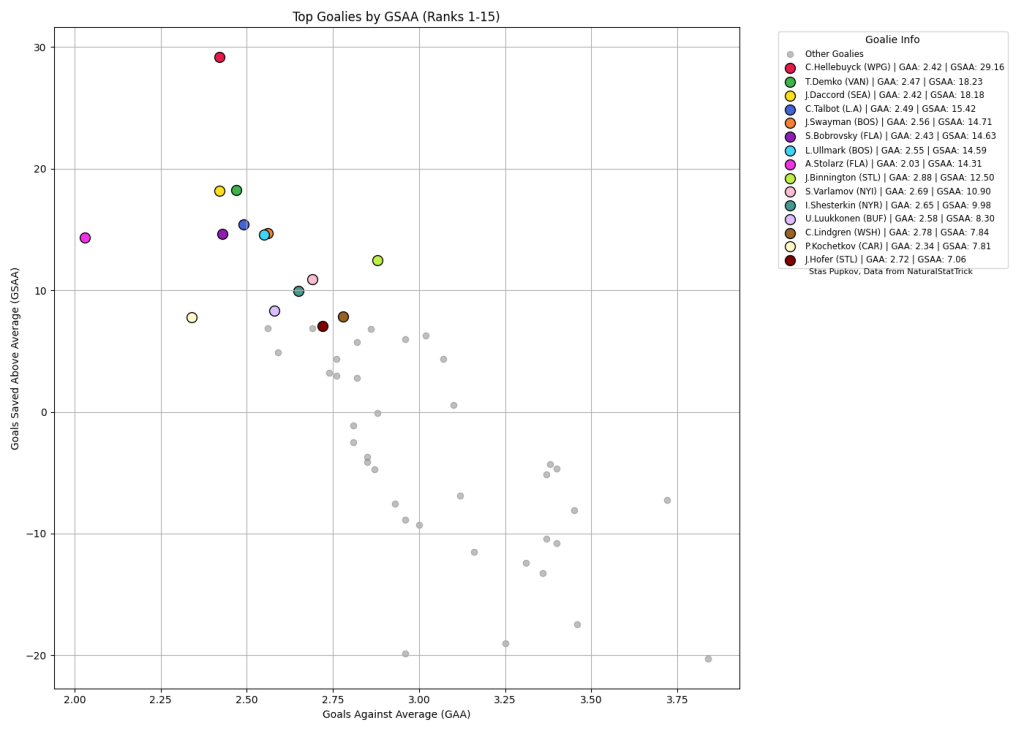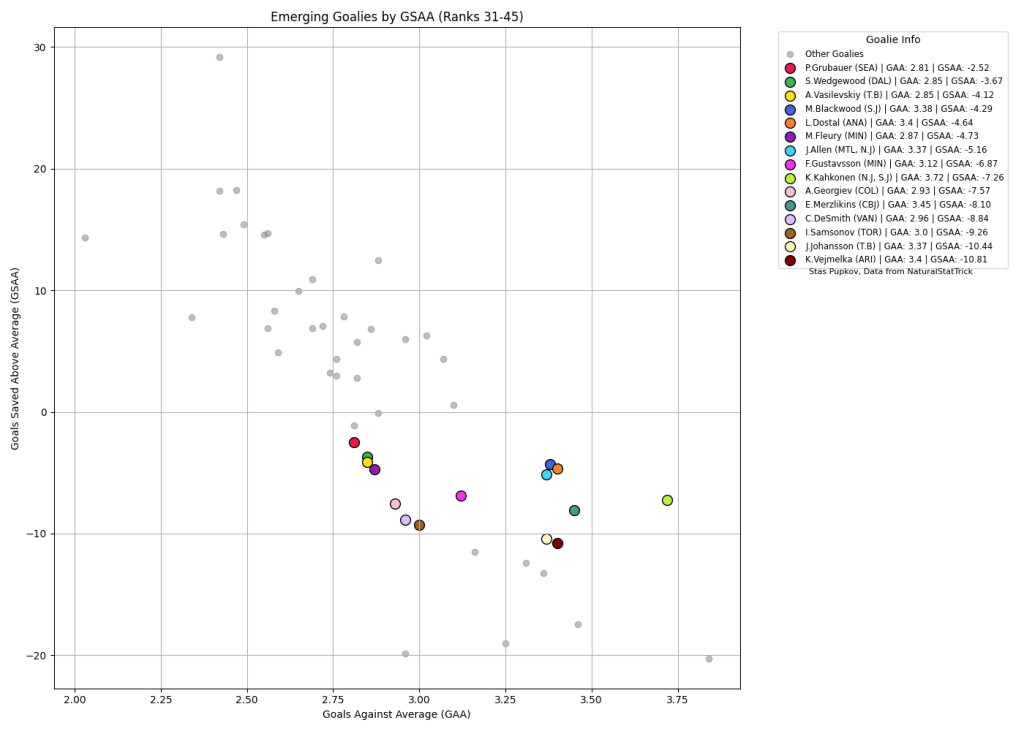In the competitive realm of fantasy hockey, the discerning manager knows the importance of a robust goaltender—an individual whose performance can swing the pendulum of league standings. Within this analytical domain, two metrics stand paramount in quantifying a goalie’s value: Goals Saved Above Average (GSAA) and Goals Against Average (GAA). These statistics offer more than mere numbers; they are the lens through which we assess a goaltender’s true influence on the ice.
This article endeavors to dissect GSAA and GAA, elucidating their interplay and significance in the context of fantasy hockey. By concentrating on goaltenders with a substantial tenure of over 25 games, our analysis aims to transcend superficial evaluations, capturing a goalie’s performance in a statistically sound manner. This threshold of games is carefully chosen to mitigate the variability inherent in smaller datasets, ensuring that the insights derived are both robust and relevant.
Join us as we navigate the nuanced metrics of goaltending, unwinding the complex threads that define the most crucial role in hockey. For the fantasy hockey manager, this exploration is not just academic—it’s a strategic compass in the quest for victory.
Understanding GSAA and GAA
In the pursuit of fantasy hockey excellence, the metrics we choose as our guideposts must be both robust and insightful. Goals Saved Above Average (GSAA) and Goals Against Average (GAA) serve as such markers, offering a dual perspective on a goaltender’s impact.
GSAA: The Differentiator
Goals Saved Above Average is the metric that measures the difference between the number of goals a goaltender has allowed versus how many they were expected to allow, given the league average save percentage and the number of shots faced. In essence, it quantifies a goalie’s performance relative to the league norm. A positive GSAA indicates that a goaltender has saved more goals than the average goalie would have, given the same number of shots, signaling superior performance.
GAA: The Benchmark
Goals Against Average, on the other hand, provides an intuitive measure of a goaltender’s reliability. Calculated by dividing the total goals allowed by the number of games played and normalizing it per sixty minutes, GAA is a long-standing benchmark of goalie evaluation. While it lacks the depth of context GSAA offers, it remains a foundational figure in determining a goalie’s performance at a glance.
The Intersection of GSAA and GAA
Together, GSAA and GAA form a comprehensive picture. Where GAA might overlook the quality of defense in front of a goaltender, GSAA adds depth, accounting for the variable nature of shots. A low GAA paired with a high GSAA is the hallmark of a goaltender who not only prevents scores but does so more than what would be expected based on the average. This intersection is where fantasy managers can find undervalued players who may be outperforming their peers but not getting the recognition due to a lack of flashy, surface-level stats.
Dissecting Goalie Performances
The Elite Guardians (Top Left Quadrant)

At the top left of our scatter plot reside the elite guardians of the goal, goalies who have not only a low GAA but also a high GSAA. Their position indicates exceptional performance; they consistently save more goals than the average goalie, even when facing a large number of shots or high-quality scoring chances. For fantasy leagues, these goaltenders are the coveted keystones, often the difference-makers who can single-handedly sway the outcome of a matchup. They are typically the workhorses of their teams, facing a barrage of shots with unwavering success, making them reliable week-to-week starters in any fantasy format.
Potential Risers (Upper Right Quadrant)
In the upper right quadrant are goaltenders with a higher GAA but also a higher GSAA. This interesting group may play for teams with less-than-stellar defenses, forcing them to face more difficult shots. Their elevated GSAA suggests that they have the skills to perform above the league average, but their circumstances result in a higher GAA. Fantasy managers might find potential risers or sleepers here — goalies who could become fantasy gold if their team’s defensive play improves or if they move to a team with better defensive support.
Steady Yet Unremarkable (Lower Left Quadrant)

The lower left quadrant tells the story of the steady yet unremarkable performers. These goaltenders boast a low GAA, which might initially attract fantasy managers. However, their GSAA is also lower, hovering around the average. They may benefit from a strong defense that limits shot quality or volume, masking the goalie’s average performance. While they might provide consistency, they lack the game-changing saves that mark the elite tier. Fantasy managers might consider them safe picks but should not expect them to carry the team as the top-tier goalies would.
Under the Radar (Bottom Right Quadrant)

Finally, in the bottom right quadrant, we find the under-the-radar goaltenders. Their unenviable position reflects a high GAA combined with a low or negative GSAA, indicating they’ve allowed more goals than the league average goalie would have under similar conditions. It’s a signal for fantasy managers to proceed with caution. These goalies might be struggling due to personal performance issues, a weak defensive team, or a combination of both. However, they might also be overlooked targets for savvy managers anticipating a bounce-back performance or a change in team circumstances that could lead to improved stats.
The Season-End Analysis of Goaltender Metrics
As the regular season winds down, our analytical journey through GSAA and GAA offers vital insights for the critical decisions that shape a fantasy hockey championship. The top-left quadrant’s elite goaltenders are proven stalwarts, likely having contributed heavily to their teams’ success. On the cusp of the playoffs, they are the ones to rely on. The potential risers, identified in the upper right quadrant, might offer late-season surges that could be difference-makers. And for those goalies in the lower quadrants, it’s a reminder to fantasy managers to consider the broader context of their team’s performance and potential off-season moves. With this strategic analysis, fantasy managers are better equipped to make those final tweaks to their roster, ensuring they’re in the best position to clinch the victory as the season concludes.
Thank you for reading and have a great rest of your day!
Twitter/X – @DH_staspup for any questions, corrections, or comments
If you want to see how your team looks on the graph, DM me a list/photo of your roster
Player Data sourced from NaturalStatTrick






 ANA
ANA UTA
UTA MIN
MIN CAR
CAR MTL
MTL NYI
NYI VGK
VGK DET
DET EDM
EDM
